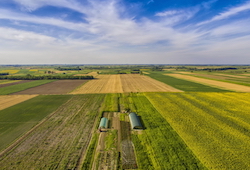Making the Common Agricultural Policy easier to follow
The RECAP project aims to help public administrations when it comes to monitoring farmers’ compliance to CAP rules (Cross Compliance and Greening) and to enable farmers to comply with the regulations. Dr Machi Simeonidou, RECAP’s Project Coordinator based at DRAXIS Environmental SA in Thessaloniki, explains, “The RECAP platform is the first solution that tried to build bridges between public administrators and farmers through the use of innovative Earth Observation (EO) solutions and cost-efficient tools. Active involvement of its users lays the foundation of the overall development of the RECAP platform, following the principle of ‘creating with the users, for the users’.” The RECAP platform provides a repository of data that can be used to guide farmers to be compliant with rules applying to their farms. It also supports public authorities when it comes to monitoring and controlling farmers’ compliance. Farm-based characteristics and administrative information is entered into the platform for each of the farmers and is then translated into personalised guidance, identifying all relevant rules that the farmer needs to comply with in their given situation. Farmers become active actors within the overall monitoring procedure. “This enables a transition towards a guidance-based system that helps farmers to understand CAP rules and comply with them, rather than penalising them for non-compliance,” says Dr Simeonidou. For example, when it comes to greening rules and cross compliance rules, specific instructions are provided to farmers explaining in simple language what they should and shouldn’t do in order to be compliant. A checklist is then created, and farmers can mark the actions undertaken and instructions they have followed. Based on the farmer’s answers, each rule applying to their farm is marked on a colour-based code as completed or pending, helping them to easily identify what is still outstanding. So what data do they draw on? Dr Simeonidou explains that open satellite and other spatial data, along with administrative data from public authorities and data generated by farmers and inspectors, are combined to provide an all-round picture. “The Remote Sensing results have been helpful for agricultural advisors, enabling them to inform farmers of necessary corrections in mistakenly declared plots, correct plot borders and any other mistakes which might cause potential non-compliance upon inspection.” Validated results regarding the Remote Sensing (RS) component, showed an overall crop type mapping accuracy in the range 80-90 % for the identification of 9-13 different crop types, depending on the case study. This profiles more than 90% of the regional agricultural zone. It’s a two-way street. Not only can farmers identify their responsibilities, but they are also able to upload information. Documents along with geotagged and timestamped photos (via a mobile application) can be uploaded by farmers in order to demonstrate they are conforming to the cross compliance (CC) rules. The feedback received by the project shows the majority of farmers that participated in the pilots, found the most useful element of the RECAP platform was the receipt of simple advice. This is tailored to each of the cross compliance and greening rules that apply to every single plot they declared. Inspectors using the platform estimated that using it reduced the time spent on each inspection by around an hour and the use of RS contributes to an overall reduction of the cost for on-the-spot checks performed by 25 %.
Keywords
RECAP, farming, common agricultural policy, compliance, farmers, public authorities

